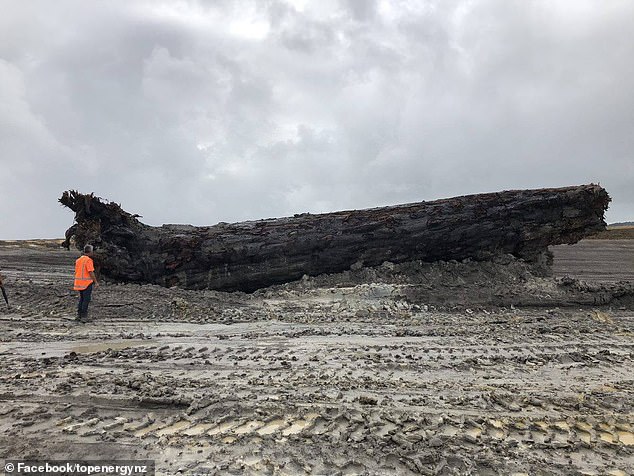The 40,000-Year-Old log is found underneath New Zealand’s swamp
A 45,000-year-old log discovered during excavations for a new power station could explain a mysterious global event which may have dramatically changed the Earth’s climate.
Scientists in New Zealand believe the 60-tonne log could hold the answers to the ancient Laschamp Event – where the earth’s north and south poles switched with each other 40,000 years ago.
The 60-tonne Kauri log was found nine metres beneath the surface in Ngāwhā on New Zealand’s north island in February and was handed over to local Maoris on Wednesday after a major excavation operation.
Top Energy, the company building the power station, began earthworks in 2017 and had excavated 900,000 cubic metres of the soil before stumbling across the 16-metre log.

Scientist Alan Hogg, from Waikato University, determined the tree dates back to 40,500 years ago, NZ Herald reported.
The mammoth log’s age sparked an interest in scientists studying the Laschamp Event – a ‘magnetic reversal’ where the Earth’s north and south magnetic poles switched places.
It was not known exactly when the reversal occurred but it was thought to have been about 41,000 years ago.
Scientists hope that studying the level of radioactive carbon in the tree’s rings would allow them to determine when the reversal occurred and for how long.
Kiwi scientists believe the magnetic reversals — and the accompanying drop in the Earth’s magnetic field strength, which allowed more solar radiation to reach the Earth’s surface — could have a major effect on climate.
‘This tree is critical, we’ve never found one of this age before,’ Mr Hogg says finding the tree was a stroke of luck which will play a huge role in future research.

Going by its size the tree was likely to have been 1500-2000 years old when it died, Mr Hogg said.
The 16-metre log was transported to nearby Ngāwhā Marae (sacred place) on Wednesday, where a ceremony was held to welcome the ancient tree to the hapū’s care (a division of Maoris).
Ngāwhā Trustees committee chairman Richard Woodman said it was a ‘fantastic acknowledgement’ from Shaw that the tree was being returned to its rightful owners rather than gifted.
Transporting the tree was a major operation, with sections of about 1.5m long needing to be cut off either end so it could be moved, with the stump alone weighing 28 tonnes.
The three sections were lifted by two 130-tonne cranes, then taken by truck five kilometres down the highway, with the whole operation taking four hours.





